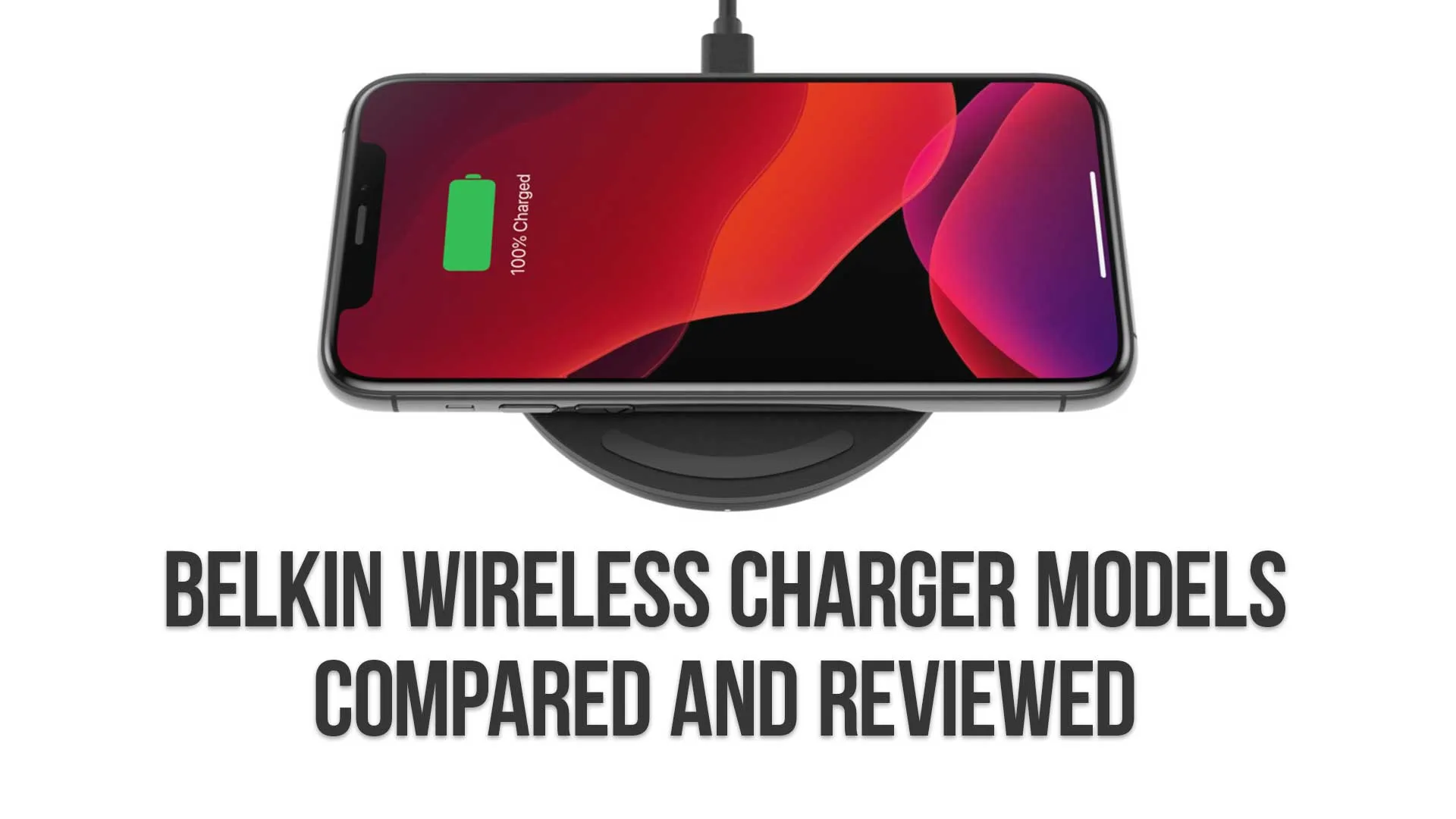This article will compare and review the wireless charging products from Belkin.
Table of Contents
- TL;DR Quick Take Reviews:
- The Reviews:
- Belkin Boost Charge Pro 3-in-1 Wireless Charging Pad with MagSafe
- BOOST CHARGE™ PRO 2-in-1 Wireless Charger Stand with MagSafe 15W
- BOOST CHARGE™ PRO Portable Fast Charger for Apple Watch
- BOOST CHARGE™ Wireless Car Charger with Vent Mount 10W
- 10W Wireless Charging Pad + QC 3.0 Wall Charger + Cable
- History of Wireless Charging
- Types of Wireless Chargers
- How Does Wireless Charging Work?
- Benefits of Wireless Charging
- Drawbacks of Wireless Charging
- Belkin Charger Wireless FAQ
TL;DR Quick Take Reviews:
Best All Around Belkin Wireless Charger: Belkin Boost Charge Pro 3-in-1 Wireless Charging Pad with MagSafe
Fastest Wireless Charging Speed: BOOST CHARGE™ PRO 2-in-1 Wireless Charger Stand with MagSafe 15W
Best-Selling Belkin Wireless Charger: BOOST CHARGE™ PRO 2-in-1 Wireless Charger Stand with MagSafe 15W
Best Belkin Wireless Charger for Apple Watch: BOOST CHARGE™ PRO Portable Fast Charger for Apple Watch
Best 3-in-1 Belkin Wireless Charger: BOOST CHARGE PRO 3-in-1 Wireless Charger with MagSafe 15W
Best Belkin Wireless Charger for Your Car: BOOST CHARGE™ Wireless Car Charger with Vent Mount 10W
The Reviews:
Belkin Boost Charge Pro 3-in-1 Wireless Charging Pad with MagSafe
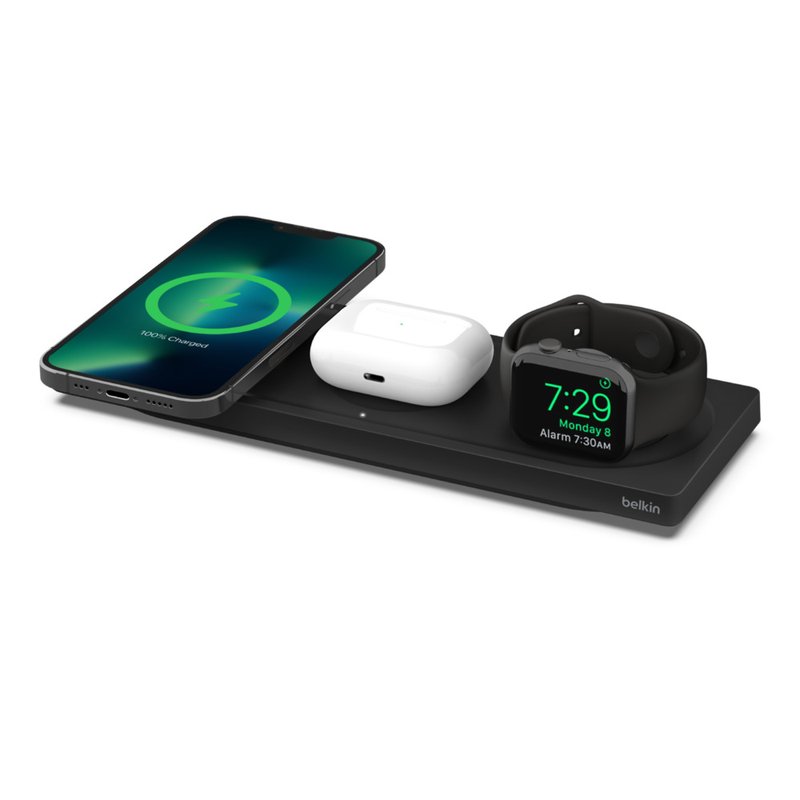
I'm naming this charger the best Wireless Charger.
It is a very Apple-focused device, but I'm firmly in the Apple camp with tons of Mac, iOS, and WatchOS devices in my house and no Android devices.
All of that that need wireless charging! It has replaced my iPhone charger in many areas of my life.
The Belkin Boost Charge Pro 3-in-1 Wireless Charging Pad with MagSafe is a charging pad that will wirelessly charge your Qi-enabled devices.
The biggest selling point on this charger is the MagSafe compatibility. If you have an iPhone 12/13, this will snap on magnetically and provide the fastest possible wireless charging speed.
You can also charge your Apple Watch with this stand, at full wireless speeds. Plus the charging pad on the bottom allows you to charge your AirPods, with the led light visible. Plus the wireless charging pad allows you to charge other qi enabled devices.
There's even an adjustable height so you can get the perfect angle for viewing notifications.
This charger includes a 15W USB Type-C power adapter and 6ft/1.8m USB Type-C to Lightning cable so you can start charging right away.
Get the Best Price for Belkin Boost Charge Pro 3-in-1 Wireless Charging Pad with MagSafe
OUR RATING: 9.5 / 10
SPECIFICATIONS
Power: 15WSize: 237.3 X 87.3 X 21.1 mm
Type: Pad
REASONS TO BUY
- Full wireless charge speed for iPhone 12/13/ and Apple Watch
- Power Supply is included
- Adjustable height and orientation for your Apple Watch
- Apple MagSafe charger for iPhones keep your expensive investment safe from breaks
- quality cable ensure optimal charge
BOOST CHARGE™ PRO 2-in-1 Wireless Charger Stand with MagSafe 15W
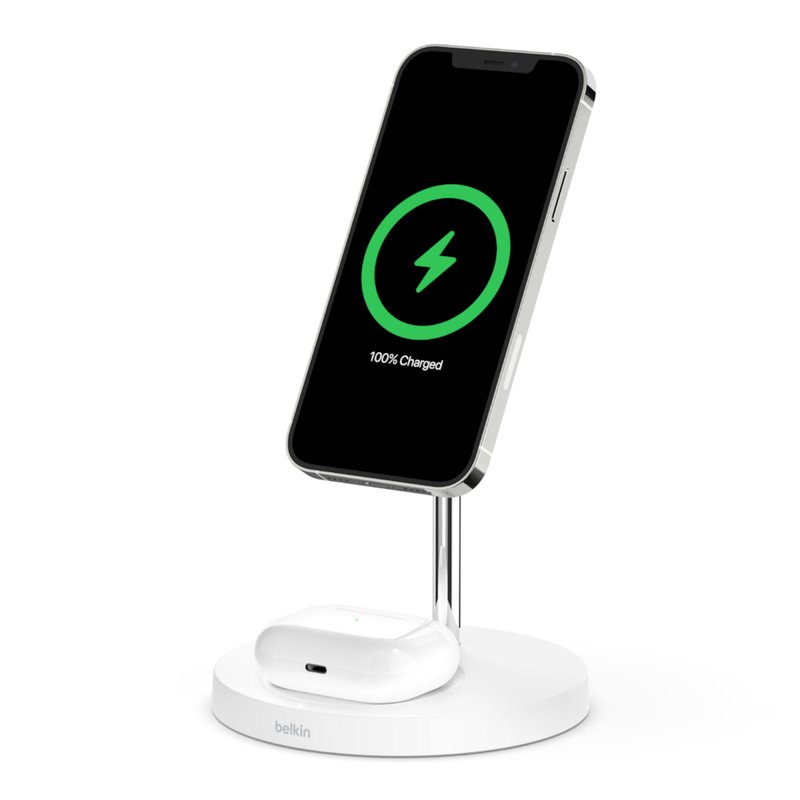
If you don't have an Apple Watch or would like the smaller form factor of a 2-in-1 wireless charger, the BOOST CHARGE™ PRO 2-in-1 Wireless Charger Stand with MagSafe 15W is for you. Charge Apple devices like iPhone XS max and AirPods at the same time.
OUR RATING: 8 / 10
SPECIFICATIONS:
Power: 15W
Size: 116.3 X 65.4 X 38.1 mm
Type: Stand
This charger also includes a 15W USB Type-C power adapter and 6ft/1.8m USB Type-C to Lightning cable in the box so you can start charging right away.
REASONS TO BUY:
- Small form factor
- MagSafe charging for iPhones keep your expensive investment safe from breaks
Get the Best Price for BOOST CHARGE™ PRO 2-in-1 Wireless Charger Stand with MagSafe 15W
BOOST CHARGE™ PRO Portable Fast Charger for Apple Watch
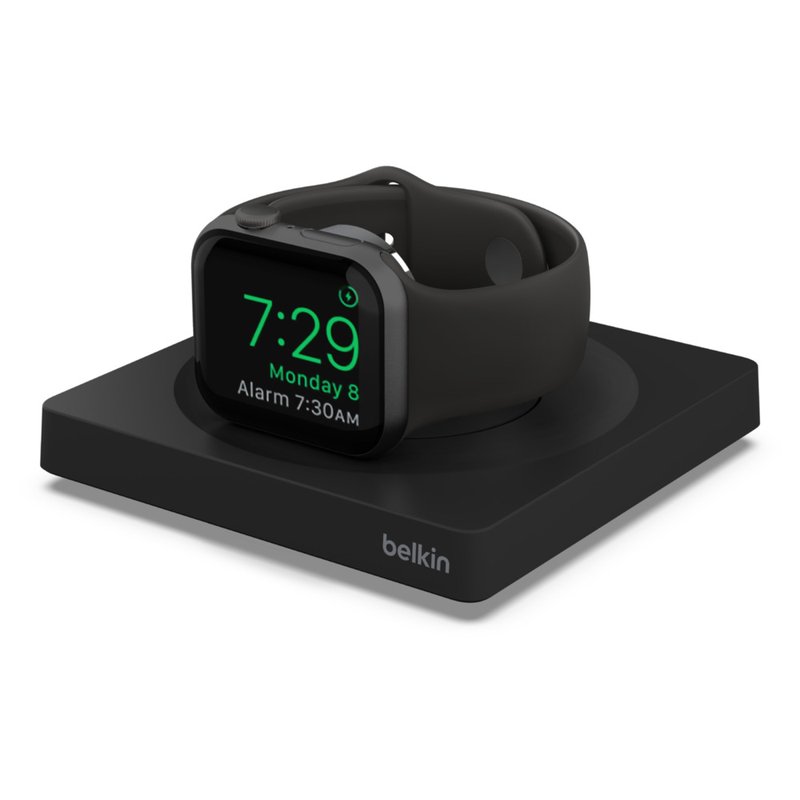
Just need to charge your Apple Watch? The BOOST CHARGE™ PRO Portable Fast Charger for Apple Watch is for you then. I like the single charger small footprint and the on-its-side charging for Nightstand Mode, perfect for replacing your alarm clock with your Apple Watch.
OUR RATING: 7.5 / 10
SPECIFICATIONS:
Power: 5W
Size: 42.4 X 42.4 X 71.8 mm
Type: Stand
REASONS TO BUY:
- Compact
- Nightstand Mode support with on-its-side charging position
Get the Best Price for BOOST CHARGE™ PRO Portable Fast Charger for Apple Watch
BOOST CHARGE™ Wireless Car Charger with Vent Mount 10W
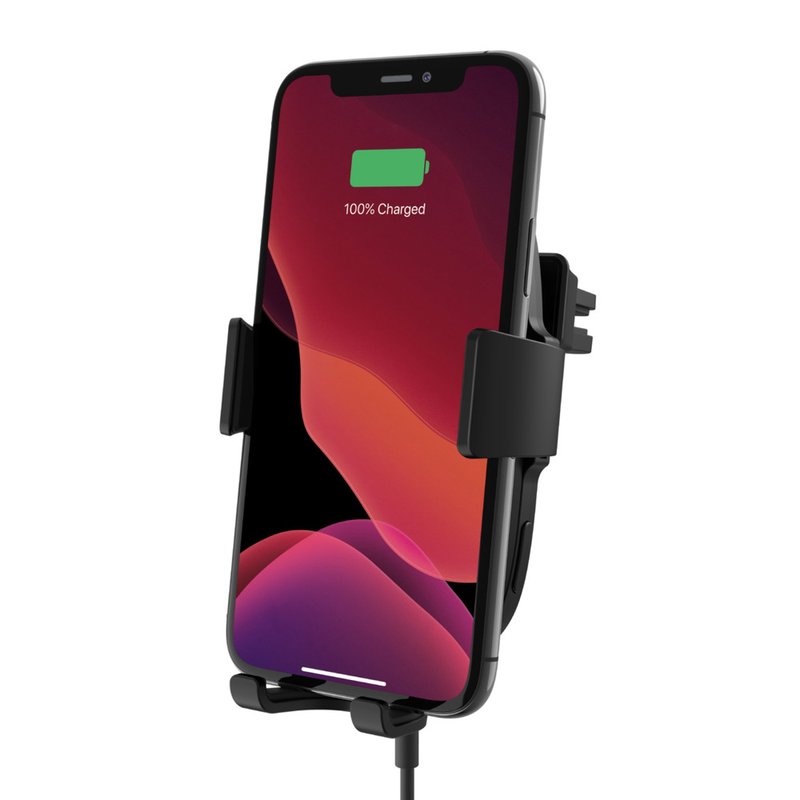
Need a wireless charging solution for your car? Look no further than the BOOST CHARGE™ Wireless Car Charger with Vent Mount 10W. These devices include lightweight plastic cases that hug your device and keep them safe from the bumps of the road.
This article has been very Apple-centric, but this device is perfectly acceptable for Samsung smartphones and any other Qi compatible phone.
OUR RATING: 6 / 10
SPECIFICATIONS:
Holds devices up to 3.5 inches wide
Size: 74.8 X 29.9 X 59 mm
Type: Car Charger
REASONS TO BUY:
- Lightweight plastic case protects your device from bumps and jostles
- Can use with most cases up to 3mm thick
- Adjustable air vent grip fits most vents
Get the Best Price for BOOST CHARGE™ Wireless Car Charger with Vent Mount 10W
10W Wireless Charging Pad + QC 3.0 Wall Charger + Cable
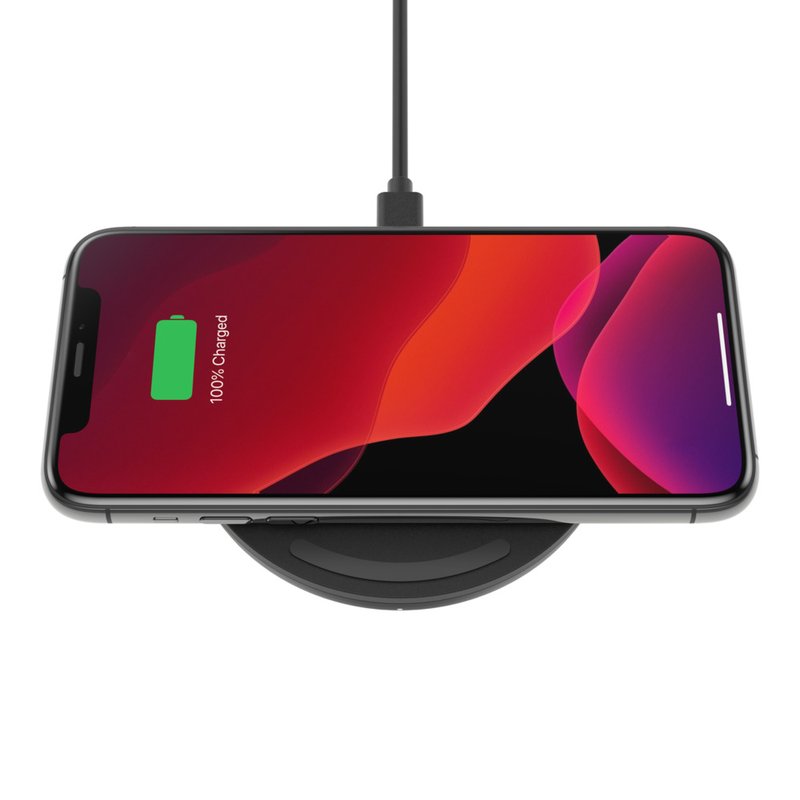
This is my favorite 10w wireless charging pad that will charge your Apple devices or any other qi enabled devices. It is not the fastest wireless charging speed, but the 10w wireless charging pad supplies an easy power boost to quick charge compatible devices without wasting any unnecessary power.
OUR RATING: 5.5 /10
SPECIFICATIONS: Historically this was one of the first wireless charger on the market that used Quick Charge 3.0
Input: 5V-2A / 9V-1.67A
Size: 87*43*10 mm
Type: Pad
REASONS TO BUY:
- It will work with any Qi-enabled device
- You can use your phone while it's charging for an easy power boost quickly
- It comes with a QC 3.0 wall charger which is great if you need to charge other devices as well
Get the Best Price for 10W Wireless Charging Pad + QC 3.0 Wall Charger + Cable
History of Wireless Charging
Wireless charging technology has been around for over 100 years! The first patent for a wireless charger was issued in 1901 to Nikola Tesla.
He envisioned a world where we could power our homes and devices wirelessly. It would be another 50 years before the first practical application of wireless charging was developed.
In 1955, researchers at the Massachusetts Institute of Technology (MIT) developed a system that could transfer power between two coils of wire using magnetic induction.
This technology is still used today in many applications, including wireless chargers.
In 2007, the Qi standard was introduced by the Wireless Power Consortium (WPC).
This standard defined how devices could be charged wirelessly using inductive charging.
The Qi standard is now used by over 300 companies and is supported by all major smartphone manufacturers.
Types of Wireless Chargers
There are three main types of wireless chargers:
- Inductive chargers use magnetic induction to transfer power between two coils of wire. This is the most common type of wireless charger and is used in many devices, including smartphones, tablets, and laptops.
- Radio frequency (RF) chargers use radio waves to transfer power between two devices. RF chargers are less common than inductive chargers but are growing in popularity due to their ability to charge devices at a distance.
- Solar-powered chargers use solar panels to convert sunlight into electrical energy that can be used to charge devices. Solar-powered chargers are still relatively new and are not as widely available as inductive or RF chargers.
How Does Wireless Charging Work?
Wireless charging works by transferring power from a charger to a device using magnetic induction or radio waves. The charger creates an electromagnetic field that induces a current in the device’s battery. This current is used to charge the battery and power the device.
Wireless charging is convenient because it eliminates the need for cables and plugs. It also reduces the risk of damage to devices from improper insertion of cables or plugs.
Benefits of Wireless Charging
There are many benefits to wireless charging, including:
- Convenience: Wireless charging is more convenient than traditional methods because it eliminates the need for cables and plugs.
- Reduced risk of damage: Wireless charging reduces the risk of damage to devices from improper insertion of cables or plugs.
- Increased efficiency: Wireless charging is more efficient than traditional methods because it eliminates the losses associated with cable resistance.
- Safety: Wireless charging is safer than traditional methods because it eliminatess the risk of electrical shock.
- Compatibility: Wireless charging is compatible with a wide range of devices, including smartphones, tablets, and laptops.
- Environmentally friendly: Wireless chargers are typically made from environmentally friendly materials, such as recycled plastic.
Drawbacks of Wireless Charging
There are some drawbacks to wireless charging, including:
- Slower charging times: Wireless charging is typically slower than traditional methods.
- Limited range: Wireless chargers have a limited range and must be placed close to the device being charged.
- Inefficiency: Wireless chargers can be less efficient than traditional methods due to losses associated with inductive charging.
- Cost: Wireless chargers can be more expensive than traditional methods.
- Bulkiness: Wireless chargers can be bulkier than traditional methods.
Belkin Charger Wireless FAQ
Is Belkin wireless charger worth it?
Yes, I believe so. Belkin has been in the business of making quality products for many years. They have a good reputation and their products tend to work well.
How do you use a Belkin wireless charger?
Just place your Qi-enabled device on the charging pad and it will start charging. Some devices may require you to align the charger with the device in order for it to charge.
Does Belkin wireless charger need to be plugged in?
Yes, the wireless charger needs to be plugged into an outlet in order for it to work.
Is Belkin or Anker better?
This is a difficult question to answer as both companies make quality products. I personally prefer Belkin because I've had good experiences with their products in the past. However, you may prefer Anker because of their cheaper prices or because you've had good experiences with their products as well.
Why is my phone not charging on wireless charger?
There are a few reasons why your phone might not be charging on a wireless charger. The most common reason is that the phone is not properly aligned with the charger. Another reason could be that the wireless charger is not compatible with your phone. Finally, your phone may not be Qi-enabled.
Which Phones are Qi enabled devices?
Most newer phones are Qi-enabled. iPhones that are Qi-enabled include the iPhone 8, 8 Plus, X, XS, XS Max and XR. Samsung phones that are Qi-enabled include the Galaxy S8, S8 Plus, S9, S9 Plus, Note 8, Note 9 and the Galaxy S10 series.
How do you charge a Belkin wireless charger?
Just plug the wireless charger into an outlet using the included AC adapter. Then place your Qi-enabled device on the charging pad and it will start charging. Some devices may require you to align the charger with the device in order for it to charge.
How long does it take to charge a phone on a Belkin wireless charger?
It typically takes around 2-3 hours to fully charge a phone on a wireless charger. This varies depending on the phone though. For example, it will take less time to charge a Galaxy S10 on a wireless charger than it would take to charge an iPhone 8.
Can I use my phone while it's charging on a Belkin wireless charger?
Yes, you can!
Is Belkin Wireless Charger good for iPhone?
Yes, the Belkin Wireless Charger is a good option for charging your iPhone. It is compatible with all Qi-enabled iPhones and it offers fast wireless charging speeds.
Is Belkin boost charge fast charging?
Yes, the Belkin Boost Charge is a fast wireless charger. It can charge your phone from 0 to 50% in just 30 minutes. That is super fast wireless charging in my book!
What is Belkin boost up?
The Belkin Boost Up is a wireless charger that is compatible with all Qi-enabled devices. It offers fast wireless charging speeds and it has a built-in fan to keep your device cool while it charges.
Does the Belkin boost charge work with iPhone 8?
Yes, the Belkin Boost Charge is compatible with the iPhone 8. It will charge your iPhone 8 wirelessly at the fastest possible speed.
Is 10W good for wireless charging?
Yes, 10W is a good speed for wireless charging. It will charge your phone fairly quickly. The fastest wireless chargers can charge your phone or tablet at 15W or more though.
How long will 10W wireless charger take?
It will take around 2-3 hours to fully charge a phone on a 10W wireless charger. This varies depending on the phone though. For example, it will take less time to charge a Galaxy S10 on a wireless charge than it would take to charge an iPhone 8.
How do I setup my Belkin charging pad?
To setup your Belkin charging pad, just plug it into an outlet using the included AC adapter. Then place your Qi-enabled device on the charging pad and it will start charging. Some devices may require you to align the charger with the device in order for it to charge.
Is wireless charging bad for battery life?
No, wireless charging is not bad for your battery life. In fact, it is actually better for your battery than traditional wired charging. Wireless charging is slower though, so it will take longer to charge your phone.
Should I remove my case before wireless charging?
Yes, you should remove your case before wireless charging. This is because most cases are made of metal and they can interfere with the charging process.
Which is better 10W or 15W wireless charging?
The 15W wireless charge device is better because it will charge your phone faster. The 10W wireless charge is still good though and it will charge your phone at a decent speed.
Is Belkin wireless charging 10W compatible with iPhone 12?
Yes, the Belkin Wireless Charging Pad 10W is compatible with the iPhone 12. It will charge your iPhone 12 wirelessly at the fastest possible speed.
How do I charge my AirPods with Belkin boost?
To charge your AirPods with Belkin boost, just place them on the charging pad and they will start charging. You do not need to remove the case. The AirPods will charge through the case.
How long does it take to charge AirPods on Belkin boost?
It takes around 2 hours to fully charge the AirPods on the Belkin Boost Wireless Charging Pad. This is assuming that you are using a fast charger though. If you are using a slower charger, it will take longer to charge the AirPods.
***

About the Author
Joseph Nilo has been working professionally in all aspects of audio and video production for over twenty years. His day-to-day work finds him working as a video editor, 2D and 3D motion graphics designer, voiceover artist and audio engineer, and colorist for corporate projects and feature films.
Table of Contents
- TL;DR Quick Take Reviews:
- The Reviews:
- Belkin Boost Charge Pro 3-in-1 Wireless Charging Pad with MagSafe
- BOOST CHARGE™ PRO 2-in-1 Wireless Charger Stand with MagSafe 15W
- BOOST CHARGE™ PRO Portable Fast Charger for Apple Watch
- BOOST CHARGE™ Wireless Car Charger with Vent Mount 10W
- 10W Wireless Charging Pad + QC 3.0 Wall Charger + Cable
- History of Wireless Charging
- Types of Wireless Chargers
- How Does Wireless Charging Work?
- Benefits of Wireless Charging
- Drawbacks of Wireless Charging
- Belkin Charger Wireless FAQ
